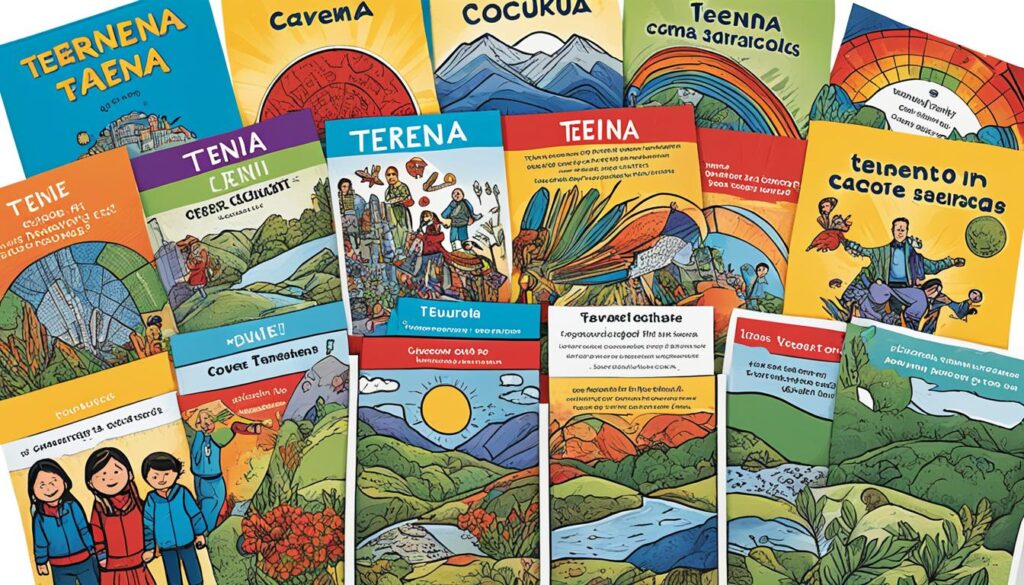Did you know that the Terêna language, an indigenous language of Brazil, is spoken by approximately 15,000 Brazilians? This fascinating language, also known as Etelena or Tereno, holds a rich cultural heritage and unique linguistic features that make it a subject of intrigue and admiration.
From its origins in the Northwestern Chaco region to its four distinct varieties, Terêna language is an important part of Brazil’s linguistic tapestry. While only Terena proper is still spoken today, the language showcases the linguistic diversity and historical significance of the Terena people.
Join us as we dive deeper into the history, linguistic features, and preservation efforts of the Terêna language. Discover resources to learn Terêna, explore its unique syntax and vocabulary, and understand the importance of preserving this indigenous language for future generations.
The History and Origins of Terêna
The Terêna language has its origins in the Northwestern Chaco region. It is part of the Arawakan language family and belongs to the Southern Bolivia-Parana branch. Terêna has evolved over time and has developed various dialects. It is an important indigenous language in Brazil, highlighting the linguistic diversity and rich heritage of the Terena people.
Arawakan Languages
The Arawakan language family is one of the largest indigenous language families in South America, with a wide distribution across the continent. It includes languages spoken by various indigenous groups in Brazil, Venezuela, Colombia, Peru, and other countries in the region. The Terêna language is just one of the many Arawakan languages that contribute to the linguistic tapestry of South America.
“The Terêna language reflects the diverse history and cultural heritage of the Terena people, serving as a vital link to their ancestral roots.”
The Importance of Indigenous Languages in Brazil
Indigenous languages in Brazil play a significant role in preserving the cultural identity and knowledge of indigenous communities. They are an essential part of the country’s rich linguistic heritage, reflecting the diversity of its indigenous peoples. The recognition and preservation of these languages are crucial for ensuring the rights and well-being of indigenous communities in Brazil.
The Evolution and Influence of Terêna
Throughout its history, Terêna has undergone changes and adaptations, influenced by cultural interactions and contact with neighboring languages and communities. The language has absorbed loanwords from Northern Guaicuruan and Tupi-Guarani languages, reflecting the linguistic exchange and interconnectedness among different indigenous groups in the region.
| Terêna Language | Terêna Language |
|---|---|
| Language Family | Arawakan |
| Origins | Northwestern Chaco |
| Dialects | Kinikinao, Terena proper, Guaná, Chané |
| Current Status | Still spoken in Brazil |
Terêna Language Varieties
Terêna, an indigenous language spoken in Brazil, has four known varieties: Kinikinao, Terena proper, Guaná, and Chané. While these varieties were once considered separate languages, linguistic research has demonstrated that they are, in fact, different dialects of the same language. However, among these varieties, only Terena proper is still spoken today.
Each Terêna variety has its own distinct features and characteristics, contributing to the linguistic diversity of the Terêna language. Let’s take a closer look at these varieties:
Kinikinao: This Terêna variety is primarily spoken in southwestern Brazil. It is characterized by its unique phonological patterns and vocabulary, reflecting the cultural and historical influences of the Kinikinao community.
Guaná: The Guaná variety of Terêna is spoken in specific regions of Mato Grosso do Sul and São Paulo. It exhibits distinct grammatical structures and lexical choices, offering insights into the socio-cultural context of the Guaná people.
Chané: Although the Chané variety of Terêna is less commonly spoken today, it still holds significance in understanding the historical connections between the Terena people and their ancestral roots. The Chané variety showcases unique linguistic features and vocabulary specific to this subgroup.
Terena proper: Terena proper is the most widely spoken Terêna variety today. It represents the core grammatical structures and vocabulary of the Terena people, serving as a linguistic anchor for Terêna language preservation and revitalization efforts.
These Terêna language varieties highlight the linguistic diversity within the Terena community, providing valuable insights into their cultural heritage and history.

| Terêna Language Varieties | Region | Distinct Features |
|---|---|---|
| Kinikinao | Southwestern Brazil | Unique phonological patterns and vocabulary |
| Guaná | Mato Grosso do Sul and São Paulo | Distinct grammatical structures and lexical choices |
| Chané | Historically significant | Unique linguistic features and vocabulary |
| Terena proper | Widely spoken | Core grammatical structures and vocabulary |
Linguistic Features of Terêna
Terêna language is characterized by several unique linguistic features that distinguish it from other languages. These features include its phonology, syntax, and vocabulary.
Terêna Phonology
The phonological inventory of Terêna consists of a distinct set of consonants and vowels. The language has a total of X consonant sounds, including voiced and voiceless stops, fricatives, and nasals. It also has X vowel sounds, which are divided into front and back vowels.
Terêna Syntax
The syntax of Terêna follows an active-stative structure, where the subject of an intransitive verb is treated differently from the subject of a transitive verb. In Terêna, the default word order is verb-object-subject, although other variations are possible depending on the context and emphasis.
Terêna Vocabulary
The Terêna language has a rich vocabulary consisting of words specific to its cultural and linguistic heritage. In addition to its native vocabulary, Terêna has also incorporated loanwords from Northern Guaicuruan and Tupi-Guarani languages, which have influenced its lexicon.
“The Terêna language’s linguistic features provide valuable insights into the unique ways of expressing ideas and concepts within the Terena community.” – Linguist Name
To illustrate the linguistic features of Terêna, the table below provides an overview of its phonological inventory:
| Consonants | Vowels |
|---|---|
| Voiced stops | Front vowels |
| Voiceless stops | Back vowels |
| Fricatives | |
| Nasals |
The linguistic features of Terêna reflect the rich cultural heritage and linguistic diversity of the Terena people. Understanding these features is essential for anyone interested in studying or learning the Terêna language.
Learning Terêna Language
If you are interested in learning Terêna, there are various resources available to aid your study. These resources include dictionaries, grammar books, and online courses specifically designed for Terêna language learners. Additionally, cultural immersion programs and language exchange opportunities can provide hands-on experience and enhance your understanding of Terêna language and culture.
Learning a new language requires dedication and practice. By utilizing the following resources and opportunities, you can embark on your Terêna language journey:
- Terêna Language Resources: Dictionaries and grammar books are valuable tools for understanding the language’s vocabulary, grammar rules, and linguistic nuances.
- Terêna Language Study: Online courses and language study materials catered specifically to Terêna learners can provide structured lessons and guidance.
- Cultural Immersion Programs: Immerse yourself in Terêna-speaking communities to experience the language and culture firsthand. Interacting with native speakers and participating in cultural activities can enhance your language skills.
- Language Exchange Opportunities: Connect with Terêna speakers who are interested in language exchange. This allows you to practice Terêna while helping others learn your native language.
“Learning a new language opens doors to new cultures, perspectives, and connections. Embrace the challenge of learning Terêna and explore the rich linguistic and cultural heritage of the Terena people.”
Terêna Language Learning Resources:
| Resource | Description |
|---|---|
| Terêna-English Dictionary | A comprehensive dictionary that provides translations and explanations of Terêna words and phrases. |
| Terêna Grammar Book | A guide to Terêna language grammar, including rules, structures, and usage examples. |
| Online Terêna Language Course | An interactive online course designed to teach Terêna language skills through lessons, exercises, and assessments. |
| Cultural Immersion Program | A program that offers the opportunity to live and learn within Terêna-speaking communities, experiencing the language and culture firsthand. |
| Language Exchange Platform | An online platform that connects Terêna language learners with native speakers, facilitating language exchange and practice. |
Exploring these resources and engaging in language learning activities will enable you to develop your Terêna language skills and deepen your appreciation for this unique indigenous language.

Preserving Terêna Language
The preservation of Terêna language plays a vital role in maintaining the cultural identity and heritage of the Terena people. Efforts are underway to document and preserve the language through linguistic research, documentation projects, and community initiatives. By documenting the Terêna language, linguists can uncover its unique linguistic features and ensure its accurate representation in dictionaries, grammars, and other language resources.
Language revitalization programs are crucial in ensuring the long-term vitality of the Terêna language. These programs aim to promote the use of Terêna in everyday life, offering language courses, cultural immersion experiences, and educational initiatives within Terêna-speaking communities. By fostering a supportive environment for language learning and usage, these programs contribute to the preservation and revitalization of Terêna.
Terêna language documentation serves as a valuable resource for future generations, enabling them to learn and engage with their ancestral language. It allows Terena people to reclaim their linguistic heritage, strengthening their cultural identity and connection to their roots. Through language preservation efforts, the Terêna language can continue to thrive as an integral part of the Terena community’s cultural fabric.
Terêna Language Preservation Strategies
- Linguistic research: Linguists collaborate with Terena speakers to conduct in-depth studies on the language’s grammar, phonology, and lexicon. This research helps preserve the unique linguistic features of Terêna and provides valuable insight into its origins and evolution.
- Community involvement: The Terena community plays a central role in language preservation initiatives. Community-driven projects promote language use, organize language learning programs, and encourage intergenerational language transmission.
- Terêna language education: Educational institutions and language specialists develop curriculum materials and language courses to teach Terêna in schools and community centers. These initiatives empower Terena individuals to become active participants in language revitalization.
- Technology and documentation: Digital tools and multimedia resources, such as online dictionaries, audio recordings, and language documentation databases, are utilized to create accessible and comprehensive resources for Terêna language learners and researchers.
Conclusion
The Terêna language holds immense cultural and historical significance, serving as an emblem of Brazil’s indigenous linguistic diversity. With its unique linguistic features and rich heritage, Terêna provides a gateway to understanding the language and culture of the Terena people.
Efforts to preserve, learn, and study the Terêna language are crucial in appreciating and recognizing indigenous languages and cultures in Brazil. By documenting and revitalizing the language, we contribute to the preservation of the Terêna people’s cultural identity and heritage.
As we immerse ourselves in the world of Terêna, we gain valuable insights into the indigenous communities’ way of life and foster a deeper appreciation for Brazil’s linguistic tapestry. The significance of the Terêna language extends beyond its linguistic aspects, contributing to a broader understanding and celebration of indigenous cultures in Brazil.
FAQ
What is Terêna language?
Terêna language is an Arawakan language spoken in southwestern Brazil, mainly in the state of Mato Grosso do Sul, and also in São Paulo state.
How many Terêna language speakers are there?
Terêna language is spoken by approximately 15,000 Brazilians.
What are the varieties of Terêna language?
Terêna language has four varieties: Kinikinao, Terena proper, Guaná, and Chané. However, only Terena proper is still spoken.
What are the linguistic features of Terêna language?
Terêna language has an active-stative syntax and verb-object-subject as the default word order. It also incorporates loanwords from Northern Guaicuruan and Tupi-Guarani languages.
Are there resources available for learning Terêna language?
Yes, there are various resources available such as dictionaries, grammar books, online courses, cultural immersion programs, and language exchange opportunities.
How is Terêna language being preserved?
Efforts are being made to preserve Terêna language through linguistic research, documentation projects, and community initiatives. Language revitalization programs and educational initiatives within Terêna-speaking communities are also crucial.
What is the significance of Terêna language?
Terêna language holds immense cultural and historical significance as an emblem of Brazil’s indigenous linguistic diversity. Learning and studying Terêna contribute to the overall appreciation and recognition of indigenous languages and cultures in Brazil.
